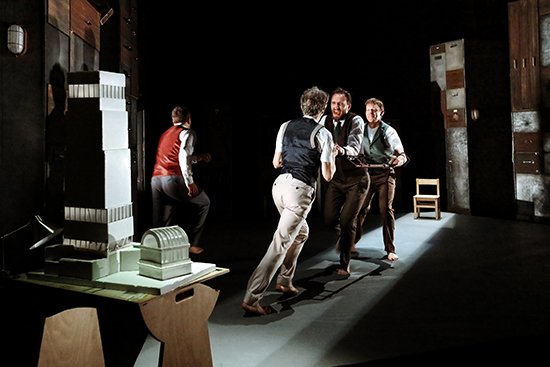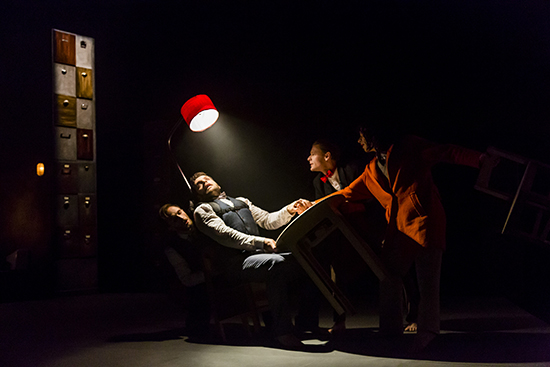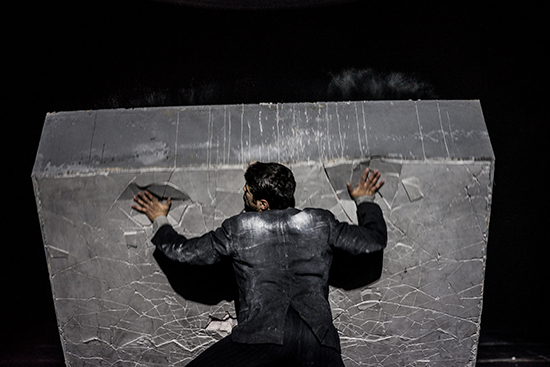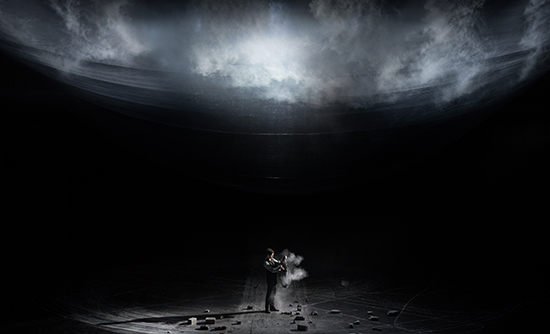Art at labour’s limits
Nikki Heywood: Institute; Still Life

Institute, Gecko
photo Prudence Upton courtesy Sydney Festival 2017
Institute, Gecko
In the final week of Sydney Festival, two works revealed humans controlled by outside forces, operating in endless loops of predetermined behaviour. Still Life draws on Albert Camus’ reading of the absurdity of the Greek Sisyphean myth—”the struggle itself towards the heights is enough to fill a man’s heart”—while the dance theatre work Institute channels a dark, Kafkaesque humour in a monstrous empathy-destroying office.
Institute
In a suffocating world of lockers and tall filing cabinets, everything is dark grey-green with a patina of an early industrial era. A muttering office worker, Martin, opens drawers and flicks through papers and is joined by his work companion, the architect. Their camaraderie turns to play as they break out of office behaviour, only to be brought back into line by lights and buzzers and a directive voice in a panopticon dystopia of ticking clocks and ringing phones.
With a taut physical language of playful exactitude and high adrenaline, the (now four) male performers dance and talk simultaneously, manipulate each other with sticks and other appendages, and magically slide new worlds out of the wall of cabinets. At one point, Martin extracts a small restaurant from one of them and engages with a phantom dinner companion, Margaret, who appears only as a pair of mannequin hands that Martin madly licks and passionately devours. Later he goes in search of her and, with a café lamp attached to his head, becomes a pilot fish. He only finds one of Margaret’s legs, then a gloved hand and a floating hat.
Later, he is a figure of sorrow, lurching around the stage with table and chair literally attached to his body as a remnant of the fictional relationship. In a gesture of sympathy, his boss Lou enables Martin’s fantasy by becoming an unconvincing stand-in Margaret, with wig and ill-fitting coat. Then, following a decree from above—”Martin, we’re going to have to let you go”—we witness his total breakdown and the awkward sympathy of his fellows as the forlorn lover is repeatedly told he has lost his grip on reality.
Throughout Institute, performers turn to recorded tapes from their pasts, fragmented episodes replayed in a secret drawer. A lush soundtrack includes the thrill of Sarah Vaughan’s “September Song” and Sinatra’s “Blue Skies,” while composer Dave Price creates an undercurrent of threat and paranoia, as in one dizzying choreographic sequence where we see, in split-second timing, flying furniture and the construction of a towering architectural maquette that can never be quite completed. Pressure to create and make decisions in bureaucratic environs leads to a moment of near suicide when the architect climbs atop a table, which is magically transformed by a lighting shift into a sheer cliff complete with an expansive sea soundscape.

Institute, Gecko
photo Prudence Upton courtesy Sydney Festival 2017
Institute, Gecko
Repeatedly overwhelmed, the men fall apart under stress, suffer panic attacks and require oxygen. The four performers take turns to rescue and medicate their stricken colleagues. Their pretence of care leads to a balletic group therapy of handholding and supported turns and twists. Upstage on an elevated platform-cum-hospital ward, a repeated motif of an old man falling backwards out of sight, to death or another beyond, is followed by the playing-out of various shapes of grief.
Towards the end, in an excruciatingly beautiful sequence even the boss Lou breaks down, isolated in a glass case. His near naked, fragile body flails and contorts slowly, accompanied by an aching vocal lament.
Gecko Theatre Company, based in Suffolk, has used this work to create dialogue with communities in the UK around mental health in the workplace. In doing so they have not only crafted a masterwork that is moving and delightful in equal measure, but extended the gesture of care beyond the stage.

Still Life, Dimitris Papaioannou
photo Julian Mommert, courtesy Sydney Festival 2017
Still Life, Dimitris Papaioannou
Still Life
Dimitris Papaioannou uses a spare stage dominated by a floating sphere of swirling cloud to highlight the ant-like scale of the human body in a vast, indifferent cosmos. He begins with a man sitting alone on the edge of emptiness. Then, the man as worker ant walks a long pathway dragging a huge square of crumbling concrete on his back.
It seems only fitting that a Greek artist would proffer the plight of Ancient Greece’s mythic Sisyphus as the pivot point for a work that muses on the weight of the material world as ballast for the lightness of evanescent spirit.
As I watched Still Life (from ‘the gods’ in row U in Carriageworks’ enormous Bay 17) the sense of scale and distance was a mixed blessing as the work offered moments of visual delight and temporal tedium. I guess the tedium, the sometimes laboured nature of an over-extended illusion, was a deliberate impost on the audience. Yet at times the accretion of images and repetition of tasks gathered into a satisfying meditative feat of endurance both for the doers and the watchers.

Still Life, Dimitris Papaioannou
photo Julian Mommert, courtesy Sydney Festival 2017
Still Life, Dimitris Papaioannou
There was time to wonder: when does a metaphorical act, in this case of ‘bodies balanced and broken apart’ cease to be an illumination of humanity’s neverending ‘search for meaning’ and become a repetitive circus trick? Perhaps when the performers play for laughs? When a clever illusion, such as being swallowed by a wall and morphing into an impossibly multi-limbed creature, is repeated ad nauseam and becomes more acrobatic than enthralling?
I have to admit that though I was less than enamoured of some stretches of this work, on reflection the strength of its elemental ponderings has stayed with me: the power of its conceptual structure; the endlessness of tape ripped from the amplified floor; the classically dressed body of a woman distorted behind a wobbling blade of Perspex; a table carried aloft by four performers—the male equivalent of the Caryatids who support the porch of the Acropolis’ Erechtheion on their heads; the dragging and scraping of the cement monolith leaving a long pale circular trace on the dark floor. Above everything the looming nebular sphere of gas is transfigured for a time into the sublime surface of an oceanic wave, prodded into movement by the tip of a performer’s shovel; while below, the presence of dust and concrete rubble alludes to the ruins of civilisation as well as to the grittiness of manual labour and the work of building and demolition.
Riffing simply from the graphics on the beautifully produced program, (still) life is what happens between the rock and the cloud. We mere mortals must be satisfied with that. Or, as Camus writes, “One must imagine Sisyphus happy.”
–
Institute, created by Amit Lahav, producer Rosalind Wynn, devising performers Chris Evans, Amit Lahav, Ryan Perkins-Gangnes, Francois Testory, set design Rhys Jarman, Amit Lahav, lighting design Chris Swain, Amit Lahav, original music Dave Price, Seymour Centre Sydney, 25-28 Jan; Still Life, visual concept, direction Dimitris Papaioannou, performers Prokopis Agathokleus, Drossos Skotis, Costas Chrysafidis, Christos Strinopoulos, Kallopi Simou, Pavlina Andriopoulou, Dimitris Papaioannou, sound composition Giwrgos Poulios; Carriageworks Sydney, 27-29 Jan
RealTime issue #137 Feb-March 2017






